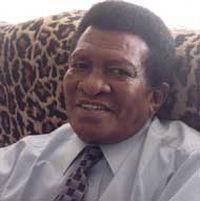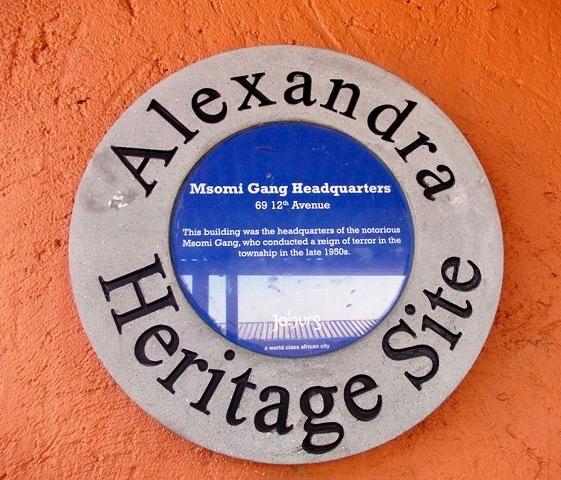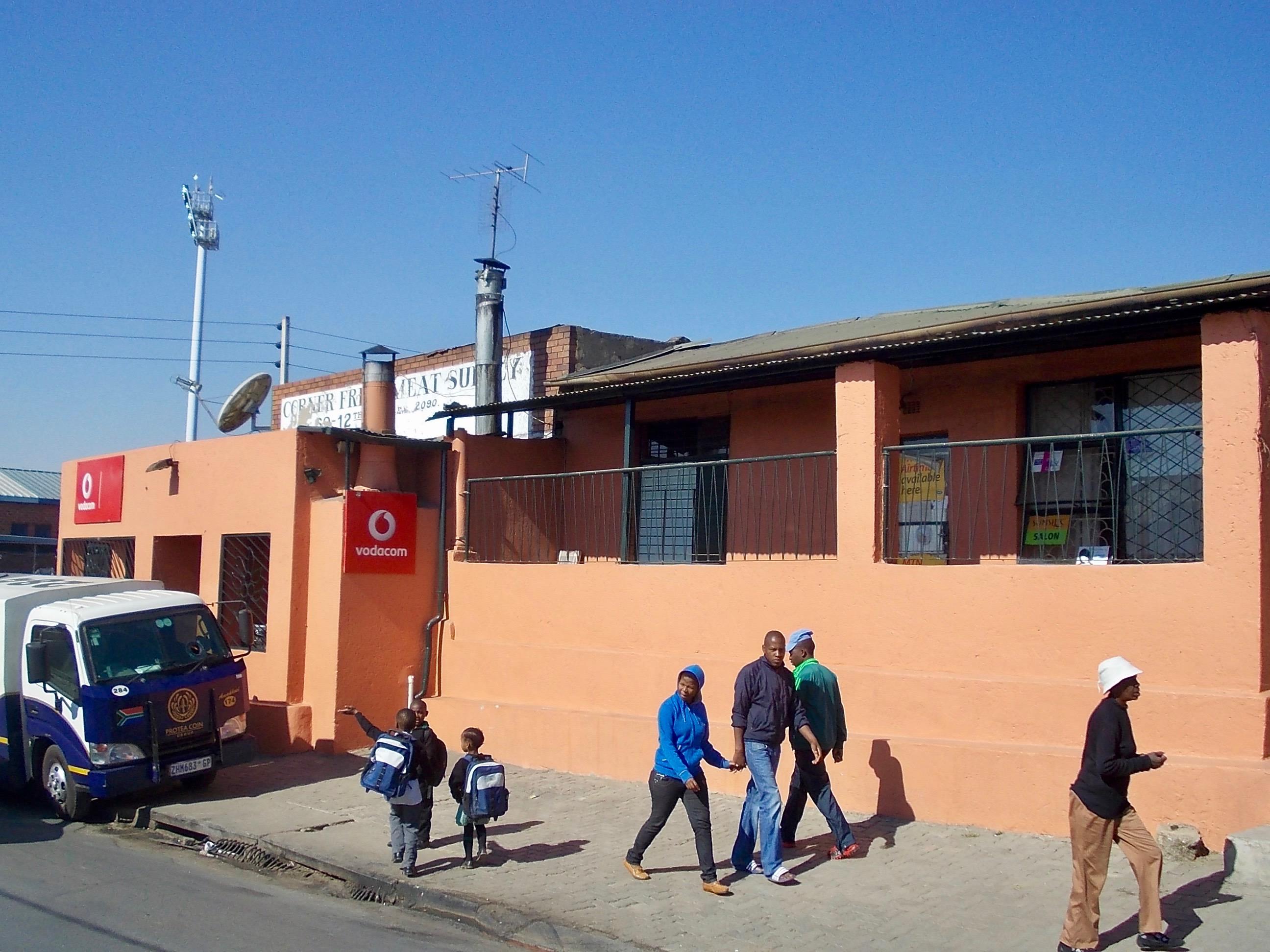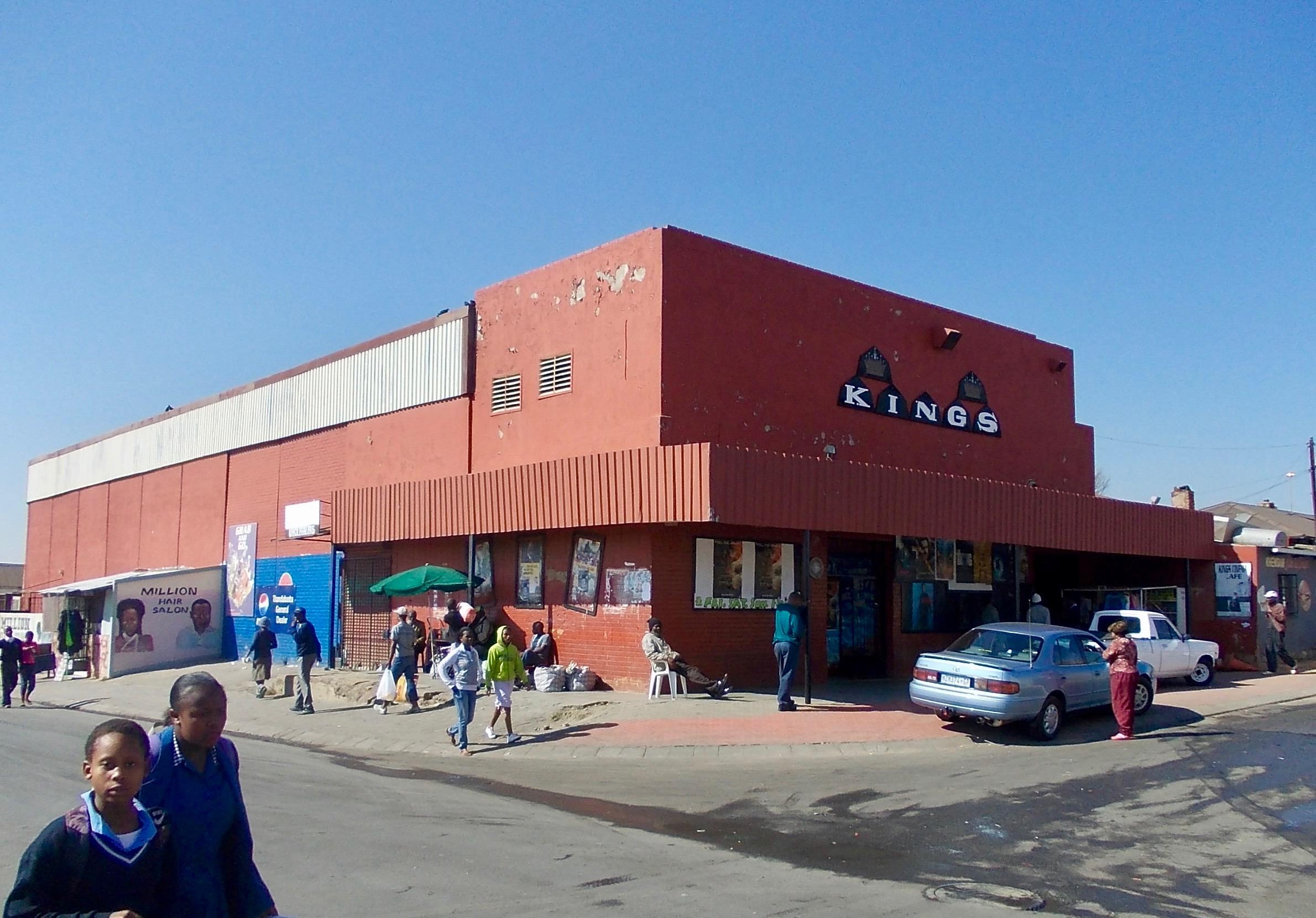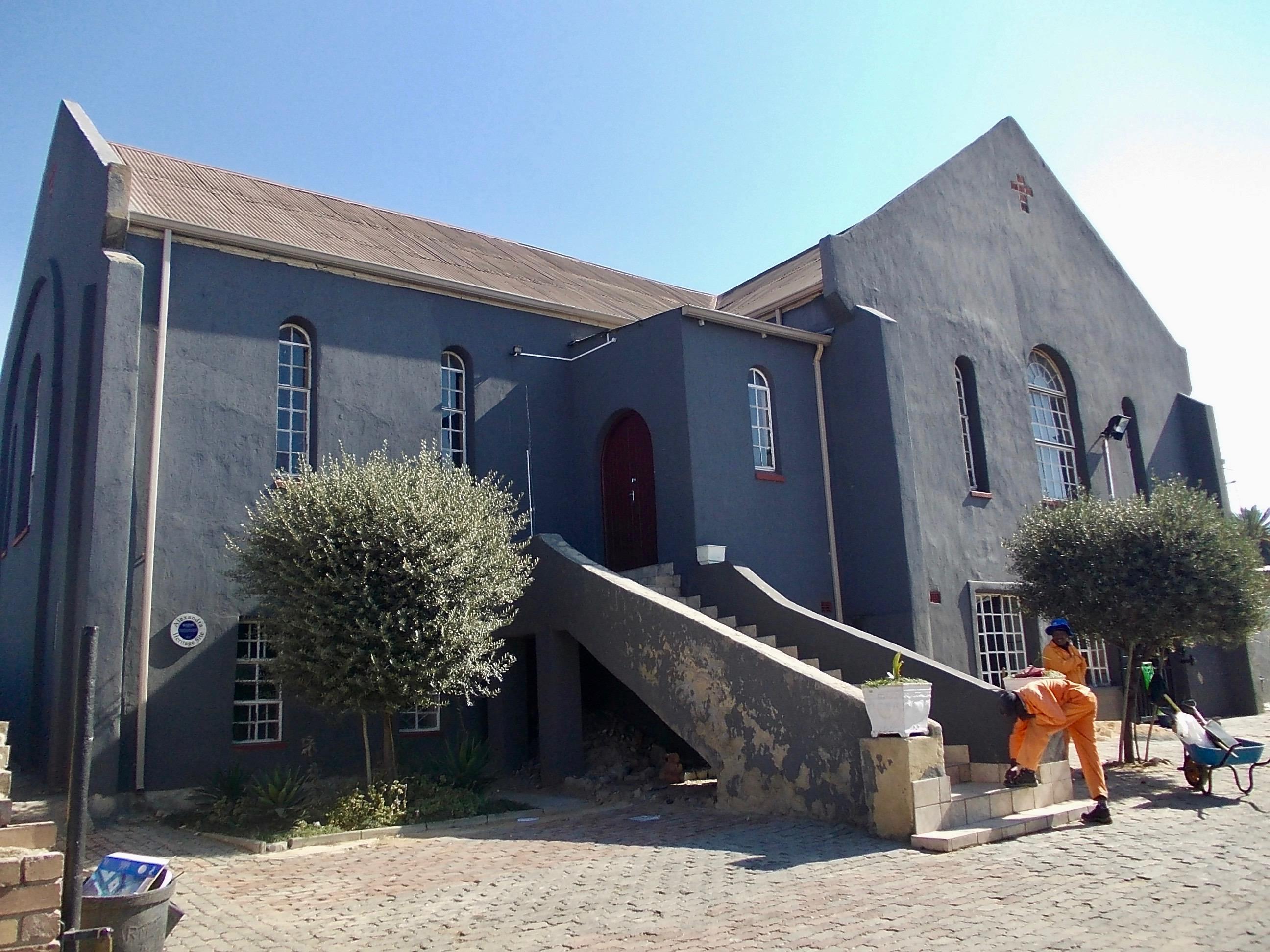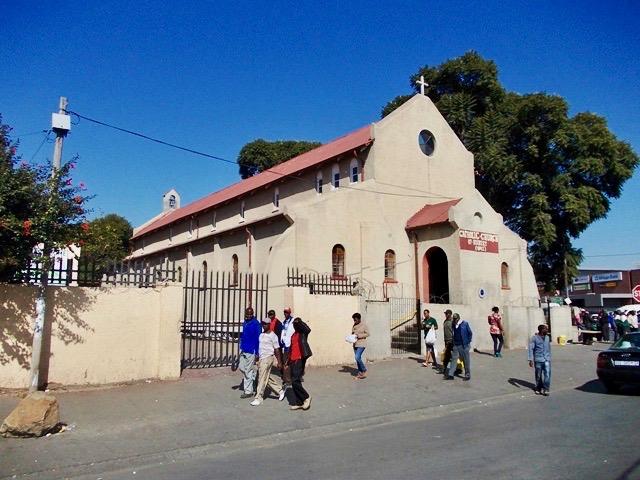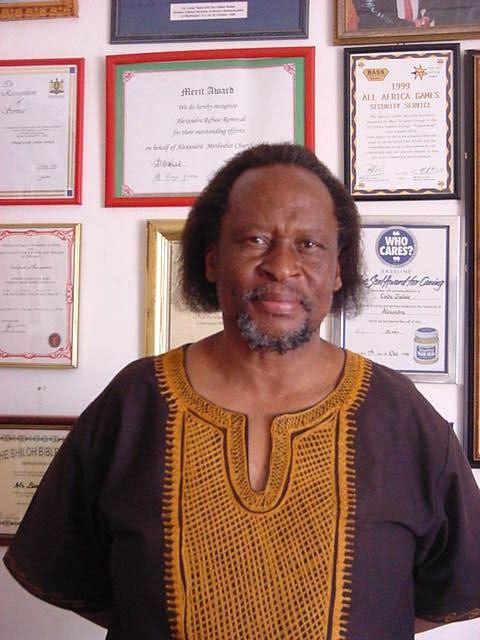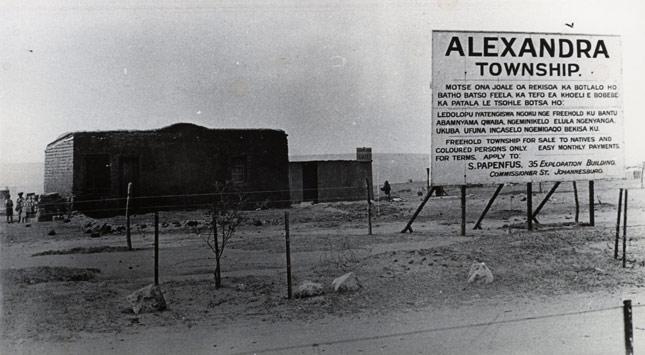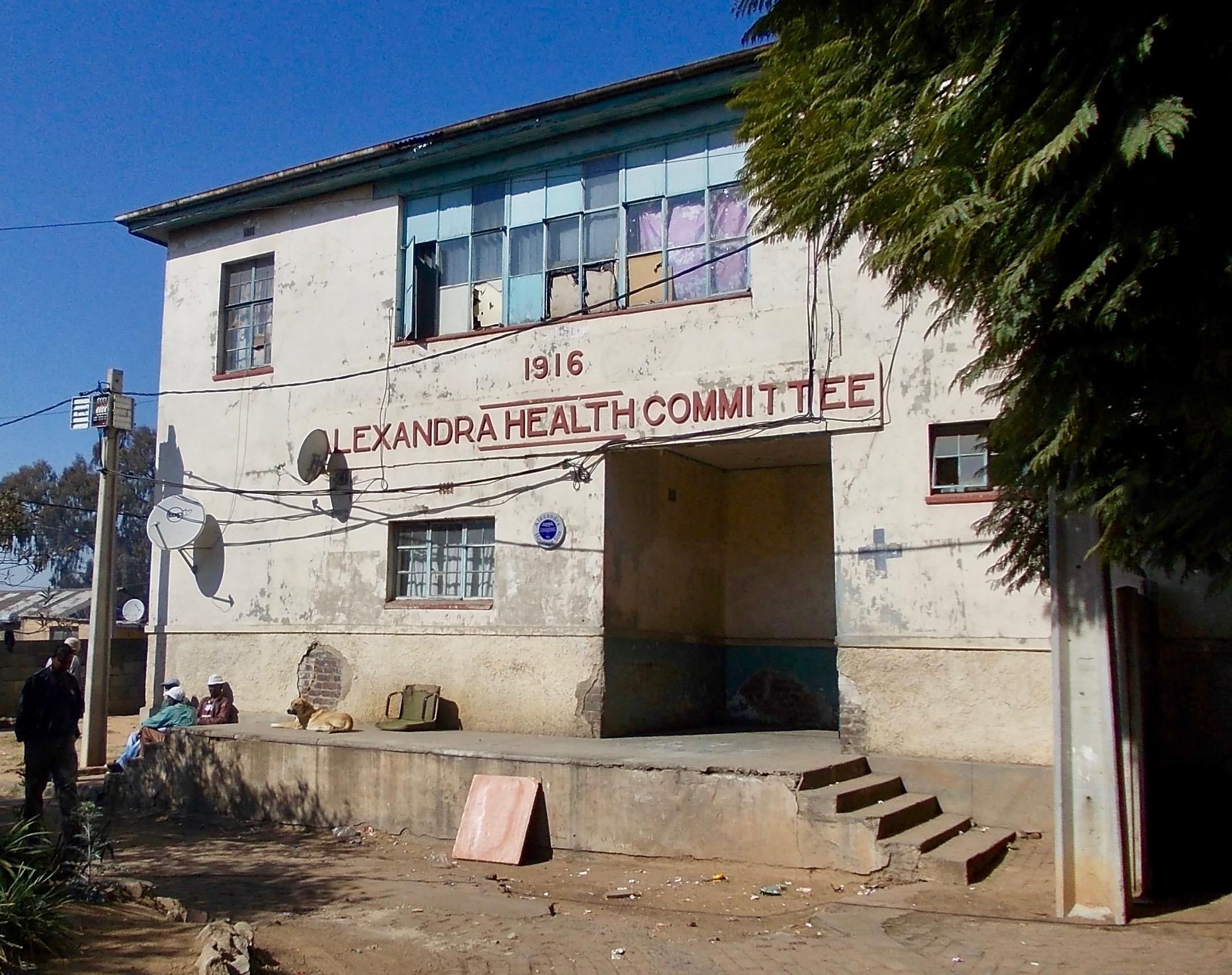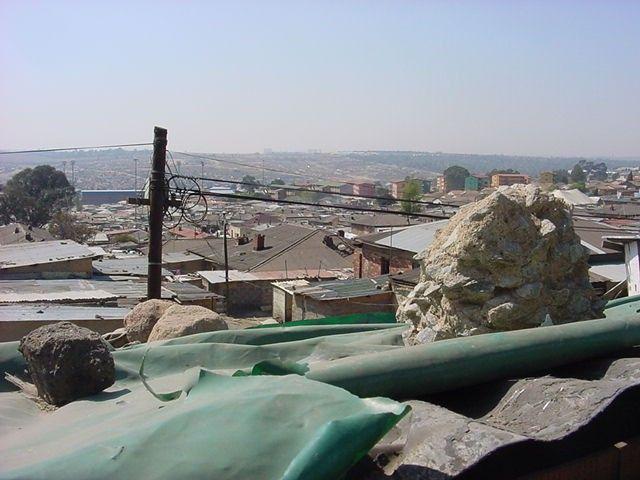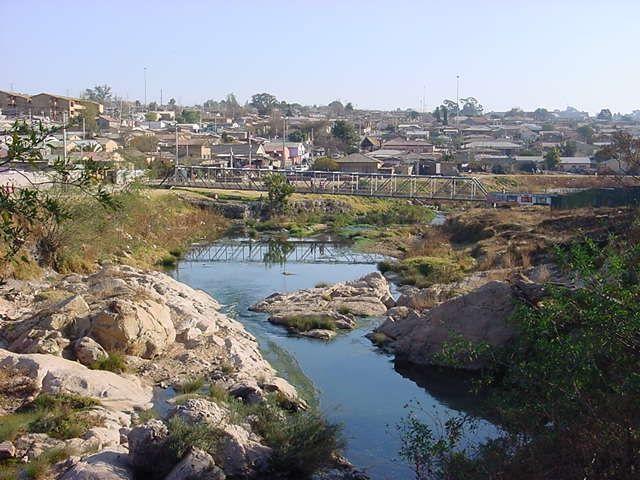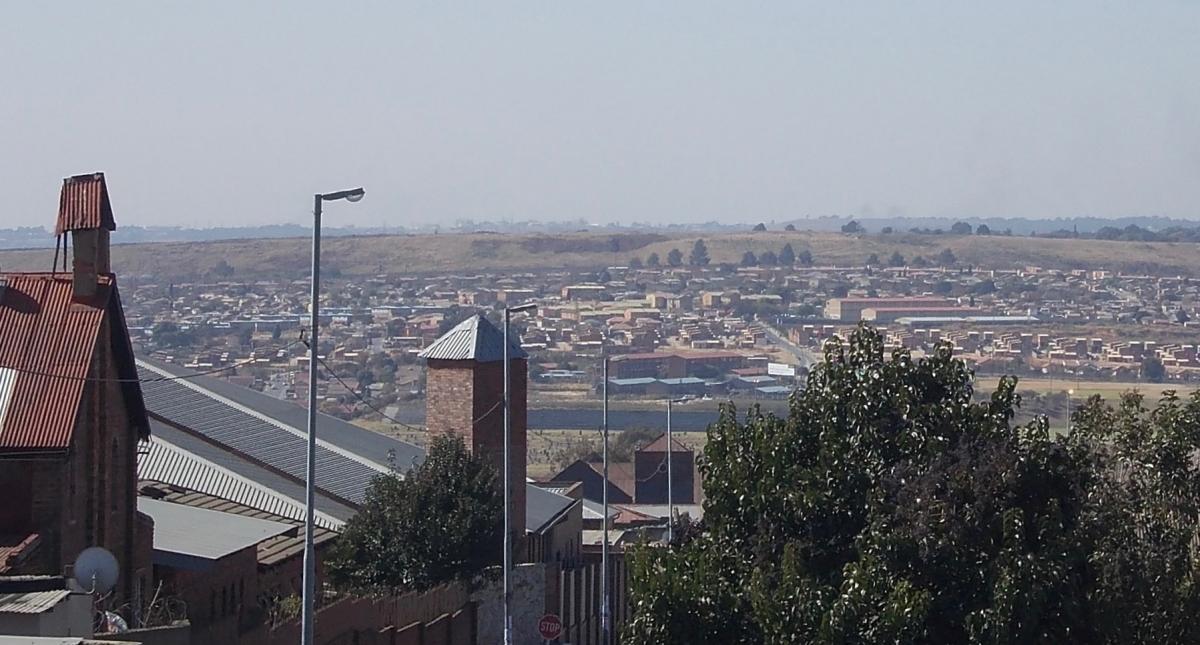
Disclaimer: Any views expressed by individuals and organisations are their own and do not in any way represent the views of The Heritage Portal. If you find any mistakes or historical inaccuracies, please contact the editor.
The article below looks at the fascinating story of how Alexandra survived demolition attempts during the apartheid years. It was written by passionate Joburger and well known journalist Lucille Davie for the City of Joburg's website on 6 October 2003. Click here to view more of Davie's work.
Alexandra has been under threat of demolition many times in its 100-year-old history. The marvel is that the township still exists. It should have been obliterated years ago, at the height of the apartheid period, when other "black spots" in the middle of white suburbs met their deaths under the bulldozers. But Alex alone survived. Because of a friendship.
A friendship between a church minister and a cabinet minister is what finally saved the township from demolition in 1979.
The church minister was the Reverend Sam Buti, who initiated and drove the Save Alex Campaign in the late 1970s, and Dr Piet Koornhof, Minister of Co-operation and Development in the apartheid government.
Reverand Sam Buti (Lucille Davie)
Their friendship came about because their fathers, both ministers in the Dutch Reformed Church in the Free State, were friends and their sons knew one another from those times. Buti spoke Afrikaans and when Koornhof was appointed minister, he approached him and said: "My mense praat van 'die erwe van ons vadere' en vra: Hoe moet ons verstaan?"
Translated, this refers to the land inherited from their fathers, meaning that the people of Alexandra failed to understand why this land was being taken away from them, a plea that Afrikaners could readily understand.
It was the key to solving the problem. Shortly afterwards, Buti got a call containing a simple message: "Alexandra gaan bly [Alexandra will remain]."
Buti recounts in the 1983 book, Alexandra, I love you that he was told to remain quiet about this news until it was announced by government. People in the township were beginning to doubt him - by 9 o'clock that evening nothing had happened. But at 9pm the South African Press Association phoned and asked for comment on the saving of Alex.
He responded: "All I could say was: "Oh my God, I'm so happy.' There wasn't anything else I could say. We all hugged one another." He was later photographed wearing a t-shirt that announced: "Thank God, Alexandra is saved".
Sprawling ghetto township
Alexandra, described by Nelson Mandela as "exhilarating and precarious", is a sprawling ghetto township some 12km north-east of the city centre. Some 170 000 (2001 Census: 166 968) people live in this ghetto, in an area of approximately two square kilometres. It's surrounded by wealthy suburbs like Sandton, Kelvin and Wendywood.
Alex, similar in some ways to Sophiatown and other townships around the country, had freehold rights for blacks and like these other ghetto townships, was a nurturing womb for musicians and artists and notorious gangsters, but unlike these townships, Alex survived demolition and continues to be a lively but desperately poor township.
Blue plaque marking the headquarters of the Msomi Gang (The Heritage Portal)
Msomi Gang Headquarters (The Heritage Portal)
The township, for decades referred to as the "dark city" because it had no electricity (Buti's was the first house to get electricity in the early 1970s), has been one of the first stops for rural blacks entering the city, being neighbours with the semi-industrial suburbs of Kew and Wynberg, and hence jobs. For decades too it had no storm water drainage, resulting in potholes and dongas opening up. Water to homes was provided by communal taps, one tap serving several households.
It has several cemeteries, now full, and 25 schools. Several clinics serve the community, with numerous spaza shops and telephone kiosks supplying basic goods and services. There's one cinema, several soccer fields and a number of churches.
Kings Cinema (The Heritage Portal)
African Methodist Church (The Heritage Portal)
St Huberts Catholic Church (The Heritage Portal)
Alex has sections where narrow alleyways separate overcrowded single-room iron shacks, and, in a reminder of its farm beginnings, unherded goats scratch for food in the piles of garbage on the streets. In other areas there are hostels of five or six storeys, or brightly-painted blocks of flats. In still other areas there're ordinary suburban streets and houses with the usual high walls and pretty pavement gardens that characterise South African suburbs.
But driving through Alex leaves one with the overall impression of squalor and desperate poverty, witnessed in the polluted streets, the overcrowded shacklands, and the many unemployed people milling about the streets. The township has very few open, green spaces and aside from a few scattered trees, very little vegetation.
But despite this Alexandra has a pull on its residents. Linda Twala, grandson of the original settlers of Alex, was born there and wouldn't live anywhere else. He calls it "a wonderful place". Many others feel the same about the township.
Linda Twala (Lucille Davie)
Back in 1904
The story of Alex goes back to 1904 when it was very much part of Johannesburg's farmlands. A wealthy farmer by the name of S Papenfus bought a number of farms around present-day Alexandra, one of which, Zandfontein, eventually became the township.
Papenfus brought his cook Hey Nxele Mbanjwa and wife, Eva, along with him and they built themselves a mud hut in the heart of Alexandra. The hut acted as a donkey refreshment station for carts carrying Papenfus' milk from his farm in Midrand to Johannesburg.
The Mbanjwas brought their five-year-old daughter Annie with them when they moved. Annie married Phumuza Twala and they had 10 children. Phumuza was a thatcher and thatched roofs in the white suburbs of Johannesburg. He died in 1971. Annie lived to the age of 99, dying in February 2003, leaving a memorable philanthropic legacy taken over by her son, Linda Twala.
Annie Twala's original mud hut was in 2nd Avenue, and she lived in it until the late 1990s, when her son replaced it with a modern two-storey home, giving it to her as a birthday present. The school she attended in 3rd Avenue, a wood and iron structure, still stands.
People from the rural areas, drawn by the possibility of jobs on the burgeoning mines, settled near to the Mbanjwas, and by 1912 Papenfus started dividing Zandfontein into plots, selling them to black families and giving them an opportunity to own land just before the 1913 Land Act took that right away from them.
Papenfus placed a board, in three languages, on the farm which read:
ALEXANDRA TOWNSHIP
Freehold township for sale to natives and coloured persons only. Easy monthly payments for terms.
Apply to: S PAPENFUS, 35 Exploration Building, Commissioner Street, Johannesburg.
Advertising board for Alexandra (via Gauteng Film website)
Papenfus needed a name for the new township. Twala recalls that Papenfus asked his grandparents what name was suitable. They replied: "Your wife, Alexandra, loves people." So it became Alexandra.
In 1912, Alex was proclaimed a "native township" and by 1916 the Alexandra Health Committee was established to manage Alexandra, a settlement that now accommodated around 30 000 people. The Committee was not given any funds by the city council for managing the township, and as it grew, with untarred roads, no rainwater drainage system, no street lighting, no sewerage system and haphazard shack settlement, it took on the appearance of a ghetto.
Alexandra Health Committee Building (The Heritage Portal)
First removals
In 1948, the National Party was elected into government, and it brought into law a sweep of apartheid laws. It was decided that the influx of people into Alexandra had to be controlled, and in fact the population needed to be decreased, and finally, the provisions of the 1913 Land Act had to be implemented: freehold rights had to be taken away from those residents who owned their properties.
Despite the fact that Alexandrans had already proved themselves to be responsive to protest and resilient to hardship when in 1940 a bus boycott took place, repeated three more times, in the mid-1940s some 5 000 homeless people were forcibly removed to Orlando in Soweto. But there were no homes for them in Soweto and they were dumped back in Alexandra, becoming the health committee's problem again, Alexandra being considered outside the jurisdiction of the Johannesburg City Council.
The exercise was repeated again in 1947 with 2 000 homeless people. At this time Alex had a population of 60 000 residents, according to Alexandra, I love you.
Bus boycotts
The bus boycott took place because the city wanted to increase the four-penny fare to five pennies (one penny is around R1 in today's terms). The township came out in protest, and for six months residents walked to town, a distance of up to 15km, taking them up to two hours to walk the distance each way.
This persistence and resilience paid off - at the end of six months the penny increase was dropped. But the issue was raised again in 1942, 1943 and in 1957 in a movement called "Zikwelwa" ("we will not ride").
The residents won the fourth bus boycott too, with the government passing a law that compelled employers to pick up part of the bill of increased transport, getting their workers to and from work.
Education
In 1954 the government passed the Bantu Education Act, which stated that blacks now had to submit to an inferior system of education, preparing them for inferior status in South African society. Mission and private schools, which had maintained high standards, had to now register with the Bantu Education Department, along with all public schools.
Thousands of school children boycotted their schools in April 1954, in Alexandra and around the country. Sixteen teachers in Alex lost their jobs. Cultural clubs were formed and informal teaching took place in the open. This continued for two years in Alexandra, with numbers attending the classes slowly dwindling.
The government eventually ended the impasse with an ultimatum: no child would be allowed back into a classroom if they hadn't started attending school by the beginning of 1956. Parents, concerned for their children's education, relented, and their children and future generations were subjected to the debasing and debilitating Bantu education for the next 40 years.
Removals and the reverend
Alex had been threatened with removals on and off for decades. It started back in 1942 with the North Eastern Protection League, according to urban specialist Pauline Morris in her 2000 paper Alexandra township - A history, lessons for urban renewal and some challenges for planners.
The league pushed for the abolition of Alexandra. The city council, which didn't have jurisdiction over the township, approved of the idea but backed down when faced with the cost of relocation of the residents, proposing instead, the upgrading of Alex, and its incorporation into Johannesburg.
Alternative accommodation was offered to residents and some of them took up the offer, the first of many removals of people out of Alex.
From 1948, Alexandra was administered by the Peri-Urban Health Board, and through the issuing of permits and passes, further settlement of people in the township was controlled, at the same time as freehold property was expropriated.
Police raided homes, checking on passes, and residents not in possession of the relevant documents were systemically moved out of Alexandra.
Morris says that the Alexandra population in 1948 was estimated at between 80 000 and 100 000, with plans to ideally bring the population down to 30 000. Between 1958 and 1973, some 56 000 people were removed from Alex and resettled in Soweto, and 15 000 removed to Tembisa on the East Rand.
The board started buying homes, demolishing some and renovating others, with a view to the government owning all land and houses in the township. Owners were compensated an amount of around R1 770, with the government buying 2 539 properties for an amount of R4,5-million by 1972. Not everyone who was compensated was moved from Alex, in the broader plan of maintaining a labour pool in the northern suburbs.
After the Sharpeville killings of 1960, the government clamped down on opposition parties with a state of emergency and it was decided to remove Alexandra altogether and rebuild the area as a "hostel city". Twenty-five hostels were to be built, each housing 2 500 people, for single men and women, and black people living on white properties throughout the northern suburbs were to be moved into these hostels.
There was widespread resistance to the move, including from the Johannesburg City Council. All parties felt the cost and social dislocation was not worth the enormous effort that would be needed.
But construction went ahead and Madala men's hostel went up in 1971, followed by Nobuhle hostel in 1972. A women's hostel was completed in 1981, even after it was acknowledged that it wasn't feasible, the destruction of family life being the major stumbling block.
And this is where the Reverend Sam Buti steps onto the stage to play a major role in the eventual reprieve of Alex. He established the Residents' Interim Committee in 1974.
Buti was originally a minister in the Nederduitse Gereformeerde Kerk in Africa, a breakaway branch of the Dutch Reformed Church which was exclusively for whites. In 1974, a further breakaway group including the NG Mission Church (for coloureds) was formed by the amalgamation of the two groups, calling themselves the Uniting Reformed Church.
Buti was born in Brandfort in the Free State, and is a third-generation minister. He settled in Alex in 1959 and has lived there ever since, measurably assisting to improve the quality of lives of Alex residents.
The interim committee resisted removals and was concerned about the breakdown of family life that would come with the hostel proposal.
Buti recalls that officials would remove furniture onto the streets, in preparation for the removals. "We would take the furniture back inside." The same happened with windows and doors - they'd be removed from the houses, to be promptly put back by residents. "They didn't know how to arrest us."
Meanwhile, freehold property rights were still being taken away from residents, and they were ordered to pay rent for their properties.
The committee swung into action, shooting off letters to the West Rand Administration Board (which then administered the township), a succession of cabinet ministers, among them Connie Mulder and Willie Vosloo.
Of Vosloo, Buti remarks in Alexandra, I love you: "He was a verkrampte [arch conservative] . . . but there were times when he shed tears at the facts - and the faces - we brought to his attention. I always had the feeling that he would have welcomed some form of change, but the forces around him didn't allow him to accept our point of view."
But still nothing happened. Then Koornhof was appointed Minister of Co-operation and Development. Buti could speak Koornhof's language, Afrikaans.
"He told the Minister what his flock were coming to him with . . . and he did it in the language of the church that both he and Dr Koornhof held dear," according to Alexandra, I love you.
Buti says it was a "tough time". The board tried to bribe Buti. "They offered me a big plot in Diepkloof and said they'd build me a house on one condition: I was not to interfere with what they were doing."
But Buti was not going to fall for that trick: "I said no. I was not a traitor to my people."
He says it took him and his committee two years to persuade Koornhof. What he eventually gave them was the answer the community had hoped for - that Alexandra was to be saved.
Buti's story subsequently takes on a sad irony. He got further involved in municipal politics. After fighting for Alex to be an independent municipality, he was voted on to the Alex council, and was eventually elected mayor of Alex. But Alexandrans felt he was siding with the apartheid government and betraying their interests. His house was bombed and razed to the ground. He was forced to give up his mayorship, and got more involved in church matters.
Today his reputation is fully restored but the 80s were a difficult time for him and his family.
The Master Plan
The reprieve didn't mean that Alexandrans' worries were over. The next year, in 1980, Koornhof announced the "Master Plan", which was to see the township divided into seven new suburbs with a central business area with shops, offices and light industry. New schools, sports complexes, parks and a dam were to be built. Alexandra was to become a "garden city". An amount of R25-million was to be set aside for the development, which would take five years.
The catch to the whole grand scheme was that all properties were to be bought by the government and all houses were to be demolished. Residents were to be moved into temporary houses and refurbished buses while waiting for new houses to be built.
Alexandrans appeared tolerant of the temporary inconvenience. Between 1981 and 1984 around 260 houses were built in an area known as the East Bank, over the Jukskei River. Another 2 200 houses were still to be built, but by 1985 the plan and its implementation had dried up, mainly because of cost considerations. The cost of the new houses had become unaffordable for residents, and they had resisted being moved from their homes in the first place - they were to spend years in temporary accommodation instead of months, waiting for their new homes.
But there was another factor - the 80s were a very turbulent time nationwide, with the apartheid government beginning to come off the rails under the pressure of international sanctions, disobedience campaigns, the astronomical costs of apartheid, and growing violence. In 1986, a state of emergency was declared, the government's attempt to regain some semblance of control of the situation.
The master plan for Alexandra was modified and became the Urban Renewal Plan in 1986, to be divided into three phases. Still the object was to move to private ownership as soon as possible, but what was needed was to define the borders of each person's stand clearly, mostly done from aerial surveys, conventional surveys being impossible, given the rate of overcrowding in the township.
By the end of 1987, over 6 000 stands had been surveyed and demarcated. But because of the squeeze on space, each stand was to accommodate between three and seven families, with both original stand owners and tenants - many of whom had been issued permits to be in Alex in the 1950s - feeling that they should both have rights to the property.
The first phase of the plan consisted of clearing passageways for service lanes, often obstructed by uncontrolled squatter housing. Part of this process was to classify dwellings as either permanent or temporary, depending on the building material used - bricks and blocks, or iron and other temporary material.
Residents were classified as either "qualified or disqualified", in terms of their original link to Alexandra.
Into this messy situation was introduced the abolition of influx control in 1986, the apartheid government's means of controlling the movement of blacks from rural to urban areas. Shacks started going up everywhere.
Morris says that shack numbers increased from 7 352 in 1987 to 20 000 in 1991. "Of this total some 6 000 to 7 000 were in backyards and the rest, at 12 000, were in freestanding areas."
It was impossible to control the situation. "So desperate was the search for land and living space that shacks were erected overnight on roads being prepared for paving."
This and the fact that residents felt they hadn't been consulted, together with funds running dry, led to the abandonment of the renewal plan.
Morris says of the impact of the progressive upgrades: ". . . the only conclusion that can be drawn [is] that all the attempts to upgrade Alexandra had been a dismal failure and had incurred massive financial, economic and social costs to the country and to Alexandra's residents".
In the early 1990s the township was wracked by violence in the run-up to the first democratic elections in 1994. Violence broke out between residents in the men's hostels and residents just south of the hostels, an area that became known as "Beirut". In early 1992 some 60 people were killed and nearly 600 people were injured and around 10 000 people were displaced from their homes, according to Morris.
View over Alexandra (Lucille Davie)
More development plans
In 1998 another development plan was drawn up, and like its predecessors, planned to reduce Alex's population and divide the township into development zones. "Superblocks", three-storey blocks, were to be built to house 3 000 people. Total cost was to be R3-billion.
The plan fizzled out. Meanwhile, an athletes village was constructed in 1999 for the All Africa Games on the Far East Bank. Called "Tsutsumani", it consisted of 1 700 freestanding, semi-detached and simplex units. These are now occupied by Alexandrans who have been on the housing waiting list and qualify in terms of certain criteria.
In February 2001 President Thabo Mbeki announced the Alexandra Renewal Project, a presidential project that is to lift the township onto its feet. An amount of R1.3-billion has been made available and over a period of seven years the township is to be upgraded.
The project's aims are far-reaching: to reduce unemployment by 20 percent (believed to be 60 percent at present) through skills development and supporting SMEs in Alex; upgrade existing housing and create new housing; improve service delivery and payment levels; create a clean living environment by upgrading parks, rivers and air quality (coal is still used for cooking and heating); improve access to effective health and social services; establish a safe and secure environment with improved policing and community involvement; and finally, establish civic pride and a respect for Alex's heritage.
Work on the ambitious project has started: 7 000 people have been moved from the dangerous river banks, and those banks have been reinforced and grassed; around 2 400 houses have been built, and a further 11 500 houses are to be built in the next three years; a greening strategy is in place, in which 3 000 trees have been planted; a water-borne sanitation system is being put in place, together with sewers; in March this year a spanking new police station was opened in the township, and reportedly crime has dropped in Alex; and, to relieve the pollution and health problems, 46 000 bins have been distributed around the township.
After two years of intense planning, the project moves into the second phase with developments along London Road moving ahead.
Hopeful investment
In the last decade there have been flickers of hopeful private/public sector investment in Alex, in the quest to uplift Alexandrans' quality of life. In 1995, a lifeline counselling office was opened. And in 2000 the Bombani Shelter for Abused Women was opened, run by three volunteers from the community. In April this year the Alexandra People's Centre opened, providing an information centre, a help and complaints desk, as well as a centre for the payment of local rates, electricity and water.
After the World Summit on Sustainable Development, a resource centre used at the summit was donated to Alex. It consists of 16 computers, a call centre for five operators, an audio-visual centre with two TVs, two video machines, and a screen and cameras, and a conference/education room.
There are other private initiatives: the Alexandra Chamber of Commerce announced in May that it would be building a state-of-the-art shopping centre. Buti has just had his business plan for an environmental theme park approved by the city council, a R70-million investment initiative that involves a waterfront development, a recreational area and a community centre. He expects the first brick to be laid early in 2004.
In an effort to bring tourists and their money into the township, tours of Alex are now conducted. The township now boasts several restaurants and B&B establishments.
It seems fair to say that Alex is finally finding its feet.
Another view of Alexandra (Lucille Davie)
Famous residents of Alex
One of Alex's most famous residents was Nelson Mandela. Shortly after arriving in Johannesburg in the early 1940s, at the age of 23, he rented a single back room in Alexandra, known now as Yard 46, on the corner of 7th Avenue and Hofmeyer Street.
Blue plaque commemorating 'Mandela's Place' (The Heritage Portal)
Mandela's Place (The Heritage Portal)
He lived in this room for about a year, working at the law firm of Witkin, Sidelsky and Eidelman as a clerk/messenger, while he finished his BA degree. In Long walk to Freedom, he describes the tin-roofed room as "a shack, with a dirt floor, no heat, no electricity, no running water. But it was a place of my own and I was happy to have it". He used to study at night by candlelight.
Mandela describes the township: "Life in Alexandra was exhilarating and precarious. Its atmosphere was alive, its spirit adventurous, its people resourceful. Although the township did boast some handsome buildings, it could fairly be described as a slum, living testimony to the neglect of the authorities. The roads were unpaved and dirty, and filled with hungry, undernourished children scampering around half-naked. The air was thick with the smoke from coal fires in tin braziers and stoves. A single water tap served several houses. Pools of stinking, stagnant water full of maggots collected by the side of the road."
But there's another side to Alex, he said. "In spite of the hellish aspects of life in Alexandra, the township was also a kind of heaven. As one of the few areas of the country where Africans could acquire freehold property and run their own affairs, where people did not have to kowtow to the tyranny of white municipal authorities, Alexandra was an urban Promised Land, evidence that a section of our people had broken their ties with the rural areas and become permanent city-dwellers."
The yard and room are now a tourist site, with the Mandela Yard Interpretation Centre across the road.
Other famous residents of Alex include First Lady Zanele Mbeki, ex-Mozambican President Samora Machel, ex-cabinet ministers Alfred Nzo and Joe Modise. The township also spawned a number of sports stars such as Jason Radebe and Theo 'Black Panther' Mthembu. Musicians include Zakes Nkosi, Hugh Masekela, Ntemi Piliso, the Dark City Sisters, Joyce Mogatusi of the Mahotella Queens, and penny-whistler Jack Lerole. Artists and poets include David Koloane and Mongane Wally Serote. Political exiles include Moses Kotane.
Lucille Davie has for many years written about Jozi people and places, as well as the city's history and heritage. Take a look at lucilledavie.co.za.
Comments will load below. If for any reason none appear click here for some troubleshooting tips. If you would like to post a comment and need instructions click here.

